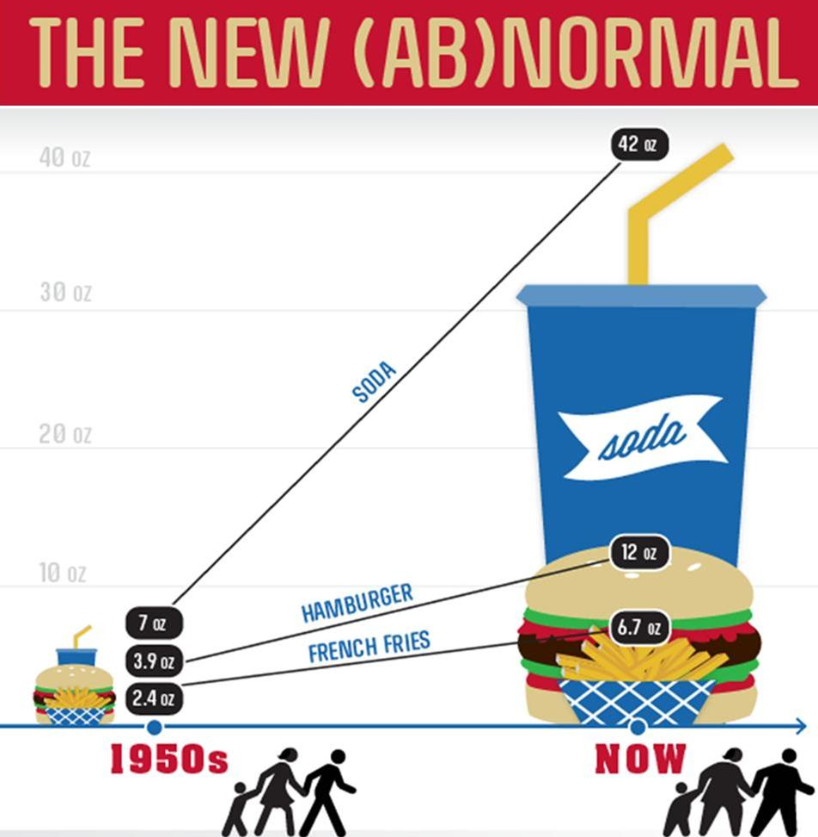Portion Distortion: Why Bigger Isn’t Always Better
Portion distortion—simply put—is the tendency to eat more food when you’re served more food. Over the past 20 to 30 years, portion sizes have ballooned across the board, from packaged items in grocery stores to restaurant meals. Fast food chains now offer “super-size” and “value-size” options, making it easier than ever to consume more than we need.
As portion sizes have grown, so has our intake of calories, fat, and added sugars. Unsurprisingly, this trend has paralleled a global rise in obesity, type 2 diabetes, and heart disease.
Bigger Portions, Bigger Problems
When we’re served larger portions, we tend to eat them—regardless of whether we’re actually hungry. Over time, this habitual overeating can override our body’s natural hunger and fullness cues, which are regulated by the hormones ghrelin (which signals hunger) and leptin (which signals fullness).
The result? We start responding more to external cues—like seeing food in front of us—and less to our body’s internal signals.
What Does Portion Distortion Look Like?
Portion sizes have quietly doubled—or even tripled—over the years. Here are just a few examples:
-
Bagels grew from 3 inches in diameter to more than 6 inches.
-
Soda bottles increased from 6.5 ounces to 20 ounces (or more).
-
French fries expanded from 2.4 ounces to 6.9 ounces.
-
Grilled chicken Caesar salad ballooned from 1.5 cups to 3.5 cups.
Because of this shift, we’ve lost sight of what a normal portion looks like. In fact, when presented with a true serving size, it may feel like we’re being shortchanged.
So, How Can You Keep Your Portions in Check?
Awareness is key. Tuning into your body’s hunger and fullness cues is a powerful first step. But there are also practical strategies you can adopt to fight portion distortion:
-
Read Nutrition Labels: Pay attention to the serving size—it’s often smaller than you think.
-
Skip Super-Sizing: Opt for regular portions when dining out or ordering takeout.
-
Split Your Meal: Eat half at the restaurant and take the rest home, or share your meal.
-
Go Pre-Portioned: Choose individually wrapped snacks to help avoid mindless overeating.
-
Use Smaller Plates: A smaller plate can help naturally limit how much you serve yourself.
-
Fill Up on Fiber: Whole grains, fruits, vegetables, and legumes promote satiety and prevent overeating.
-
Slow Down: Take your time and check in with how you feel—hungry, satisfied, or full. Avoid rushing through meals.
| Food Type | Standard Serving Size | Visual Cue |
|---|---|---|
| Cut vegetables, sliced fruit, cooked beans, pasta, rice, grains, cold cereal | 1 cup | Baseball size or closed fist |
| Bagel or bread | 3 oz | Hockey puck or palm center |
| Nuts, seeds, nut butters | 1 oz or 2 tablespoons | Golf ball or small cupped palm |
| Dried fruit, crackers, pretzels, cheese | 2 oz | 2 golf balls or large cupped handful |
| Cooked meat, poultry, fish, tofu | 3–4 oz | Deck of cards or palm up to knuckles |
| Spreads (jam, butter, mayo, oil) | 1 teaspoon | Postage stamp or fingertip (to first knuckle) |
Final Thought
In a world where “more” is often marketed as “better,” it’s easy to lose track of what a healthy portion really looks like. But by becoming more mindful of how much we eat—and why—we can take back control of our health, one plate at a time.
Portion control isn’t about restriction; it’s about balance, awareness, and honoring your body’s true needs.
